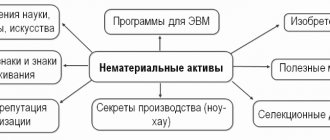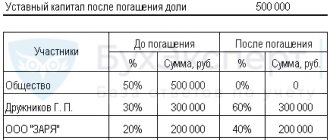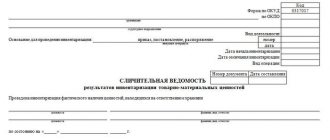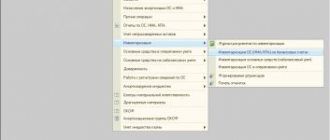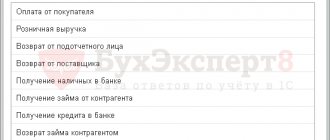If an organization works with cash, a certain percentage of errors is almost inevitable. Cash discrepancies are especially frequent in companies where the cash flow is very extensive and the persons responsible for it often change, for example, in supermarkets with a large number of cash registers, large shopping centers, etc.
Let's consider what the right thing to do in such cases is for the management of the organization, which threatens the cashier who does not keep track of part of the money, and we will also reveal the features of accounting for the shortage through accounting.
Who can identify the shortage?
A shortfall is an identified negative discrepancy between financial accounting indicators and the actual amount of cash in the operating cash register.
NOTE! If there are more funds than would be due according to the documents (positive discrepancy), we are talking about surpluses going to the organization’s profit.
Who and during what procedures can detect such a discrepancy? The most common shortages are:
- the cashier-operator himself;
- an employee performing cashier functions;
- the cashier's immediate superiors;
- inventory commission;
- auditor checking the cash register;
- founders or shareholders of the company;
- senior management;
- auditors during an external audit.
All these persons have the right to reconcile accounting data and count cash in the cash desk at the required time on the basis of paragraphs 37 and 38 of the Procedure for conducting cash transactions in the Russian Federation, approved by decision of the Board of Directors of the Bank of Russia dated September 22, 1993 No. 40.
Cash audit rules
The cash register inventory is carried out at a frequency established by order of management and enshrined in the accounting policy of the enterprise. The same regulations establish the inventory procedure. The cashier is recognized as the financially responsible person for the cash register.
Before the inventory, the manager (director) issues an order (order), which indicates the start date and composition of the inspection commission.
The commission must include at least three people. The presence of the MOL on the commission's list is mandatory. In addition, the presence of security and internal audit employees (if available) is desirable. If there is no signature of even one of the commission members, the inventory is considered invalid.
Before checking, the cashier stops all operations and generates a cash report.
Example of a cash report
This report reflects all incoming and outgoing orders, which, in addition, must comply with the approved forms. Identified missing or excess amounts are reflected in accounting during the audit period.
During the inventory the following is also checked:
- Setting a limit on the balance of DS at the cash desk;
- Inconsistency between the dates of cash receipts and the actual issuance of money;
- Correctness of correspondence of cash document accounts;
- Whether unpaid wages were deposited on time.
Based on the results of the inventory, an inventory report INV-15 is drawn up. In commercial organizations, surpluses and shortages are written off to the financial result.
Example of an inventory report
Unscheduled audit of the cash register
The cash register inventory can be carried out unscheduled, suddenly and without warning, in order to control the responsibility of the MOL. The timing and procedure for unscheduled inventory are also established by the regulations of the enterprise.
It's always the cashier's fault
The cashier is entrusted with storage of material assets (in this case, cash proceeds) on the basis of an employment contract concluded with him.
Art. 242 of the Labor Code of the Russian Federation states that in such situations the employee bears full financial responsibility for compensation for lost funds. A Art. 244 stipulates the legality of concluding such an agreement with employees holding the position of cashier if they have reached the age of majority. In addition to cashiers, full financial responsibility falls on some other categories of workers provided for by Resolution of the Ministry of Labor of Russia No. 85 of December 31, 2002.
BY THE WAY! In the event of damage to the company, the cashier may be guilty not only of unlawful actions, but also of inaction, as well as negligence and dishonesty in relation to his own labor duties.
Types of liability for shortages
- Full financial responsibility. This implies reimbursement of the entire missing amount at the expense of the cashier. If the amount that needs to be reimbursed is no more than the average monthly salary of the culprit, then he must reimburse it by order of management, issued no later than a month from the date of discovery of the shortage. Large sums can only be recovered through judicial proceedings. The employer has a year to go to court on this matter.
- Administrative penalty. The cashier, through his action, inaction or negligence, violated the procedure for handling cash, which means he may be subject to administrative liability. Officials can pay 4–5 thousand rubles, and legal entities – 40–50 thousand rubles. - this is in addition to compensation for the amount of the shortfall itself.
- Disciplinary action. May also be imposed by the employer, in addition to damages. A careless cashier can be reprimanded, reprimanded, and in some cases fired without mercy.
- Criminal liability. Threatens those officials in respect of whom the intent of their actions has been proven. Such guilty actions are recognized as:
- theft - secret appropriation of someone else's property;
- fraud - the acquisition of rights to someone else's funds due to abuse of trust or deception;
- embezzlement – theft of entrusted property or funds and subsequent sale, use, transfer to third parties;
- misappropriation – unlawful retention of entrusted assets for one’s use.
ATTENTION! You will have to file a claim in court if the cashier does not agree to voluntarily pay the funds, as well as after the expiration of the established month.
These actions are punished, depending on the severity, the possibility of relapse and the category of the guilty employee, either by a fine, or by compulsory or correctional labor, or by restriction of freedom, arrest or prison. The specific time limits depend on the type of criminal act.
Criminal liability for lack of money in the cash register
| № | Type of offense | Sanction | Term, amount |
| 1. | Theft | Fine | Up to 80,000 rub. or in the amount of salary or income for six months |
| Mandatory work | Up to 180 hours | ||
| Correctional work | From six months to a year | ||
| Restriction of freedom | Up to 2 years | ||
| Arrest | From 2 to 4 months | ||
| Deprivation of liberty | Up to 2 years | ||
| 2. | Fraud | Fine | Up to 120,000 rub. or in the amount of an annual salary or other income |
| Mandatory work | Up to 180 hours | ||
| Correctional work | From 6 months to a year | ||
| Restriction of freedom | Up to 2 years | ||
| Arrest | From 2 to 4 months | ||
| Deprivation of liberty | Up to 2 years | ||
| 3 | Embezzlement, misappropriation | Fine | Up to 120,000 rub. or in the amount of annual income |
| Mandatory work | Up to 120 hours | ||
| Correctional work | Up to six months | ||
| Restriction of freedom | Up to 2 years | ||
| Deprivation of liberty | Up to 2 years |
IMPORTANT INFORMATION! For any act that provides for criminal liability, the perpetrator can be dismissed at the initiative of the employer.
A shortage was detected at the cash register: postings. How to reflect surpluses and shortages
All cash transactions are periodically audited and all valuables are checked.
The inspection is carried out by the organization's inventory commission. Its members, in the presence of a responsible person, check the availability of money, receipts for deposited valuables, check books and strict reporting forms. Inconsistencies identified during inspections are documented in accounting acts.
For more details on how a shortage is determined at the cash register, the entries that must be indicated in the balance sheet if it is detected, read on.
Values
The cash desk at an enterprise may contain cash, payment documents, securities and strict reporting forms.
Payment documents include not only receipts, but also stamps (postal, bill and state duties), vouchers to sanatoriums, air tickets and other documents.
Strict reporting forms include: receipts, certificates, diplomas, subscriptions, tickets, coupons, shipping documents, etc. The cashier bears financial responsibility for the preservation of monetary documents.
Inventory
The procedure for carrying out cash inventory is regulated by the “Procedure for maintaining the cash register No. 40”, approved by the Board of Directors of the Central Bank of the Russian Federation, and Letter of the Central Bank No. 18 dated 04.10.93.
The timing of the inspection at the enterprise is established by the manager and enshrined in the order. The inventory is carried out by a specially created commission, which includes representatives of the administration, the chief accountant and the cashier.
Before carrying out the procedure, prepares a cash report. It includes all primary documents that should be at the cash desk. If the inventory reveals unclosed statements (for salary payments), then all unpaid amounts are equated to cash. The amounts paid are recorded separately in the document.
The cashier is required to provide a receipt stating that by the time the inventory begins, payment documents have been submitted to the accounting department, and all cash has been recorded. This must be done so that upon completion of the check the cashier does not declare that he has payment documents. The cashier's report is checked against the information in the cash book and the order.
To conceal the fact of embezzlement of funds, receipts are often used as documents. But they cannot confirm the expenditure of funds, since they are not drawn up in a unified form and do not contain the signatures of the recipient, the chief accountant and the manager.
If such documents exist, then it is considered that a shortage was identified during the inventory of the cash register. The entry must be made in the balance sheet on the date of the audit. The chairman of the commission endorses all orders and attaches them to the report.
This document serves as the basis for recording fund balances.
Peculiarities
During the inventory you need to check:
- whether the cash balance in the cash register exceeded the established limit;
- targeted use of funds;
- correspondence of the date of the transaction in the cash register and the debit order;
- validity of records;
- timely return of unpaid salary balances to the account;
- correctness of paperwork;
- presence of signatures of the director, chief accountant on blank checks;
- the fact of keeping the checkbook outside the cash register;
- legality of transactions carried out within one transaction;
- correctness of correspondence invoices.
The availability of funds in the cash register is confirmed by a sheet-by-sheet count of cash, securities and monetary documents. The cashier carries out the recount in the presence of members of the commission. Money is calculated for each bill separately, starting with the highest denomination.
If there is a large number of banknotes, then an inventory is drawn up indicating the denomination and number of banknotes. This document is signed by the commission. If there is a shortage of funds, then a shortage has been identified at the cash register.
Posting to accounting using account 50 “Cash” confirms this fact.
Recalculation of forms
The actual availability of Central Bank forms and reporting documents is carried out by name, type and category of forms. For example, shares can be registered, bearer, interest-bearing and ordinary. During the check, the starting and ending numbers of the forms, their series and cost are also recorded.
All these monetary documents are registered based on the results of the inventory in the amount of expenses for their acquisition. The balance of the forms is determined based on the data in the cash book or report. If a shortage of forms is detected, the shortage is registered at the cash desk. Accounting entries are made according to analytical and synthetic accounting accounts. Examples of registration of such operations will be presented below.
Shortage at the cash desk: postings
At enterprises, cash is accounted for in account 50 “Cash”, which has three sub-accounts: 50-1 “Cash of the enterprise”, 50-2 “Operating cash”, 50-3 “Payment documents”. Reporting forms on the off-balance sheet account 006 of the same name are taken into account separately.
Identified surplus funds are subject to capitalization under the item of non-operating income. The entry DT50-1 KT91-1 is made in the control unit.
The shortage of funds in the cash register is reflected by posting using account 94 in the DT for the amount of actual expenses. Let's look at typical wiring:
– DT94 KT006 – lack of forms.
– DT94 KT50-1 (50-3) – lack of money in the cash register.
Posting DT73-2 KT94 reflects the write-off of the shortage to the cashier. Compensation for damage from an employee's salary is reflected in the entry DT70(50) KT73-2.
In the absence of a guilty person, how is the shortage reflected in the cash register? Postings:
– DT94 KT50-1 – fact of identifying a shortage of funds;
– DT91-2 KT94 – the amount of the shortage is included in non-operating expenses.
Reporting
The inventory results are reflected in the act in form No. INV-15. It includes the cashier’s explanations for the identified violations and the management’s resolution. The report is drawn up in two copies, signed by the commission and brought to the attention of management. One copy remains in the accounting department, the second - with the cashier.
Checking operating cash registers
For settlements with company employees, operating cash desks are used. The procedure for checking them differs from that described above.
The commission, in the presence of the cashier, records meter readings that reflect the amount of revenue. The data is checked against the submitted cash register tape. The difference in the balance at the beginning and end of the day reflects the daily amount of revenue. The numbers in the cash book, on the tape and on the counters must be identical.
Cash recalculation is carried out using the purchase method. The resulting balance is compared with the accounting balance. Based on the results of the inventory, a shortage of funds in the cash register may be identified. The posting, which in this case is entered into the balance sheet, looks like this: DT94 KT50-2.
Checking bank accounts
An inventory must be carried out before submitting annual reports. Since an organization can open accounts in different banks, before checking it should study in detail all banking agreements, check the legality and feasibility of opening an account.
To summarize the movement of funds in non-cash form, accounts 51 “bank account in rubles” and 52 “Currency accounts” are used in the balance sheet. To detail the information, you can use subaccounts 52-1 “Currency account in the Russian Federation” and 52-2 “Currency account abroad”.
The balance of funds is converted into rubles at the official rate twice: at the time of the transaction and during the inventory. In this case, exchange rate differences appear. Positive values are included in the financial results for non-operating income.
Negative ones are reflected in the control unit with the entry DT91-2 KT50.
Inventory is carried out by reconciling the balance of funds with the data of the statements. Additionally, the revolutions for DT and CT are compared. During the inspection, surpluses and shortages in the cash register may be identified. Postings:
– DT76-2 KT51 – identification of amounts erroneously credited to a bank account.
– DT51 KT76-2 – receipt of payments.
This is how cash register inventory is carried out at an enterprise.
Source: https://FB.ru/article/282790/obnarujena-nedostacha-v-kasse-provodki-kak-otrazit-izlishki-i-nedostachu
The procedure for collecting shortages
- Detection of monetary discrepancies in the cash register and in papers.
- Request an explanation from the cashier. In case of failure to provide or direct refusal to draw it up, a special act must be written with the signature of two witnesses.
- Issuance by management of an Order (instruction) to compensate for the shortage.
- For a cashier who agrees to voluntary compensation, the amount of the shortfall will be written off from the next salary, or he will deposit the money into the cash register himself. You can agree on an installment plan.
- If the cashier refuses a refund or if the amount is large, management goes to court.
NOTE! The employer may, after considering the circumstances and the cashier's explanation, completely waive the requirement for compensation at any stage, partially or in full.
conclusions
Like cash shortages, cash surpluses detected during an audit require certain actions on the part of the inventory commission, management, and the responsible cashier.
Everything is carefully documented by the protocol, an inventory act is necessarily drawn up, and the financially responsible entity prepares an explanatory document regarding the cash surplus.
The reasons for the appearance of unaccounted cash are clarified, the guilty party is determined, the employer issues a verdict on accepting the cash surplus for accounting and imposing sanctions on the culprit, and appropriate orders are issued.
When the cashier is not to blame
The law stipulates certain circumstances that remove guilt and financial responsibility from the cashier. These include:
- a natural disaster as a result of which the cash register was damaged and funds were lost;
- another act of force majeure independent of the cashier (robbery, theft of funds during transportation or transfer to/from the bank).
In this case, the act of shortage is recorded, in addition to the usual emergency inventory procedure, also by an act of law enforcement agencies.
How to handle accounting shortages
If the cashier is at fault, the amount of the shortfall is not taken into account for income tax purposes, since even with compensation no additional income arises. And if you had to demand the amount in court, management bears the costs of legal fees and fees: these can be legally included in non-operating expenses.
The following entries exist in accounting for these transactions.
- When the employee reimburses the entire amount shortfalls are carried out under “Other income” in the reporting period in which they were recognized by the debtor or the court:
- debit 94, credit 50 – the Nth amount of shortfall in the cash register has been identified;
- debit 73-2 “Calculations for compensation for material damage”, credit 94 - attributing the specified amount of damage to the guilty party;
- debit 70, credit 73-2 “Calculations for compensation of material damage” - the amount is withheld from the cashier’s salary or deposited into the cash register.
- The organization allowed the cashier not to reimburse the shortage. The amount that has already become irreparable damage relates to “Other expenses”:
- debit 94, credit 50 – the Nth amount of shortfall in the cash register has been identified;
- debit 73-2 “Calculations for compensation for material damage”, credit 94 - attributing the specified amount of damage to the guilty party;
- debit 91-2, credit 94 - the amount of the shortfall that is not reimbursed by the cashier is recognized as part of other expenses.
- It's not the cashier's fault. If the funds are lost as a result of force majeure, and the cashier had nothing to do with it, then the losses are attributed to non-operating expenses recognized in taxation and written off to the financial results of the company:
- debit 94, credit 50 – the Nth amount of shortfall in the cash register has been identified;
- debit 91-2, credit 74 - the shortage was written off with an unknown culprit.
Examples of accounting entries for account 94
Example 1. Lack of funds
When conducting an inventory at Dandelion LLC, a shortage of RUB 5,000.00 was identified. The shortage of funds was written off to the responsible person A.A. Vasilkova.
The accountant of Dandelion LLC generated the following entries for account 94:
| date | Account Dt | Kt account | Amount, rub. | Wiring Description | A document base |
| 16.12.2016 | 94 | 50.01 | 5 000,00 | There is a shortage in accounting | |
| 20.12.2016 | 73.02 | 94 | 5 000,00 | The shortage is written off to the guilty party | |
Example 2. Shortage within the limits of natural loss and above the norms
When conducting an inventory as of December 1, 2016. LLC "Dandelions" identified a shortage of cherry plum of 5.00 kg for a total amount of 2,500.00 rubles. Of which RUB 2,000.00. written off as natural loss, and RUB 500.00. for excess losses at the expense of the wages of A.A. Vasilkov, responsible for storage.
The accountant of Dandelion LLC generated the following entries for shortages within the limits of natural loss and above the norms:
| date | Account Dt | Kt account | Amount, rub. | Wiring Description |
| 16.12.2016 | 94 | 41 | 2 500,00 | A shortage of goods was identified during inventory |
| 20.12.2016 | 44 | 94 | 2 000,00 | Shortages within the norms are written off as sales expenses. |
| 20.12.2016 | 70 | 94 | 500,00 | Shortages in excess of norms are written off as wages |
The organization's cash desk is designed to store funds, strict reporting forms, bills and other monetary documents. Inventory is a tool for identifying surpluses and shortages in the organization's cash register. How to formalize the results of the inventory, what transactions are generated when surpluses or shortages are identified at the cash register - we will consider further.

